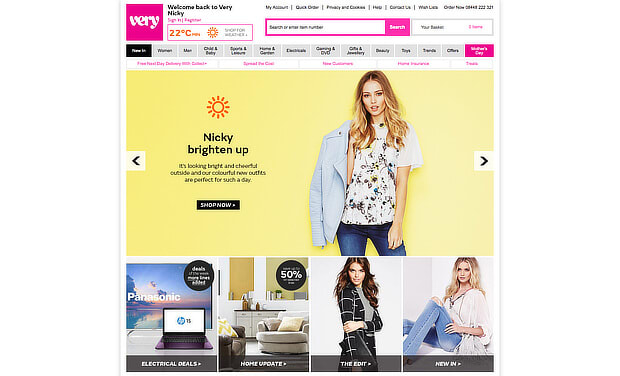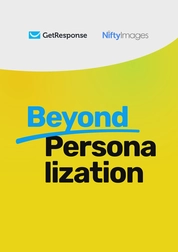For some time now, digital marketers have known that personalization drives positive results. It’s the key to creating a great customer experience. And it’s also the main way for a brand to forge and develop relationships with its customers.
But the days when adding a customer’s name to an email subject line was enough of a personalization effort have come and gone. Today’s customers expect more – and they’ll gladly go to your competitors to get it. Unless you can give them what they crave, instead.
And that’s where the latest evolution of marketing personalization comes in. It’s called hyper-personalization, and it involves the use of vast troves of customer data and sophisticated artificial intelligence (AI) to deliver relevant content and messaging to each individual customer.
It’s the secret sauce that’s driving some of today’s best-known brands to new heights. And you can use it too if you know how. To help, here’s everything you need to know about hyper-personalization. We’ll cover what it is, how it works, and why it’s different from conventional personalization. Then we’ll go over four major hyper-personalized marketing strategies and some examples of them in action.
If that sounds good to you, let’s dive in.
What is hyper-personalization?
In a nutshell, hyper-personalization is a combination of marketing and data analytics. It’s a process whereby marketers combine real-time customer data from multiple touchpoints and channels to create an ultra-detailed, per-customer marketing strategy. The data makes it possible to deploy customized advertising, products, services, and offers for each customer. And all of it’s fine-tuned for relevance to maximize consumer response.
How does it work?
Needless to say, hyper-personalization takes a lot of work. It’s only possible thanks to the latest developments in AI technology, which uses machine learning and deep learning to analyze real-time data about customers, looking for patterns that could indicate what each customer is looking for. That kind of deeper understanding of a customer’s intentions allows a brand to be in the right place at the right time – delivering the right products and services at the perfect point in the customer journey.
How is it different from conventional personalization?
Conventional personalization is different from hyper-personalization in a few critical ways. The first is that it doesn’t involve attempting to understand the individual preferences of each customer. It only serves to create the appearance that marketing messages are aimed at the individual.
That’s why conventional personalization typically doesn’t involve the use of any data beyond the customer’s name, purchase history, and location. It might, for example, include an email with the customer’s name in its subject and heading that advertises items related to a product they’ve purchased previously. But that same email (except for the name) would go out to every customer that purchased that product; the personalization is little more than an illusion.
A hyper-personalized version of that same email might take into account that the specific customer had recently searched for items in the same product category. It could be triggered by them posting a review of the original product on social media.
Or it could be based on predictive analytics that examines the customer’s location data before and after their original purchase. Then the offer they’d receive would be timed to catch them in a particular place, going beyond simple pre-determined customer segmentation.
Developing a hyper-personalization strategy
Under the hood, most AI platforms built to enable marketing hyper-personalization to work in a similar way. What’s important is how the marketer uses them to create hyper-personalization strategies. And there are four steps involved:
1. Real time data and long-term data collection
The first step in the process of developing a hyper-personalization strategy is to begin collecting relevant data about your customers. And for hyper-personalization, there’s no such thing as too much data. But in general, the types of data required fall into two categories: quantitative and qualitative data.
Quantitative data includes all information about how the individual interacts with the business. That means website activity data, personal and transactional information, social media contacts with the business, and previous interactions with customer service they may have had. Some of these data sources may be collected in real-time, and others from historical data sources. Together these paint an ongoing picture of their relationship with the business.
Qualitative data, on the other hand, relates to the customers’ motivations and feelings. To collect it, most businesses rely on online surveys, product reviews, and post-interaction questionnaires. They may also purchase consumer data sets from 3rd-party data providers to fill in any gaps in their own data.

2. Customer segmentation using customer data
Although true hyper-personalization addresses each customer individually, the process does still require the creation of customer segments (for messaging at the group level). So the next step is to create those customer segments, preferably creating the smallest groupings possible.

Using the data collected in the first step, you should be able to segment customers using data points like:
- Brand interaction history
- Purchase history
- Demographic data
- Location
- Average spend
- Satisfaction ratings
There are, of course, innumerable types of customer segments you might create beyond those six. Depending on the business type, it might make sense to add or subtract from the list, and that’s just fine. What’s important is to work to define the segments down to the smallest possible groups. Doing this will also make your standard personalization more effective.
Here’s a useful guide where you can learn more about applying segmentation to your email lists.
3. Create targeted journeys
With your segments complete, the next step is to create targeted journeys for each of them. The idea is to map out the journey a typical member of each segment makes on their way to a purchase. This information will help inform where targeted interventions might help to keep each segment member moving forward toward a sale or other desired conversion activity.

In most cases, an AI-powered hyper-personalization platform will use those intervention points in concert with more detailed user data to determine which channel to use at any given time. For example, it might know that a specific customer tends to open emails at certain hours of the day but not others.
It might also take into account their social media usage patterns to deliver a targeted ad when they’re most likely to see it. But it all begins with the targeted journeys you create, so take great care to get them right.
4. Define KPIs and measurement methods
Because the whole point of a hyper-personalization strategy is to drive sales, measuring your strategy’s impact is critical. So you must define key performance indicators (KPIs) for your hyper-personalization strategy before putting it into action. You’ll also want to set up whatever methodologies you require to measure progress toward those KPIs.
Four major hyper-personalization use cases
In practice, there are myriad ways that you might use hyper-personalization in your marketing operations. But there are four major ways that most big businesses tend to do so. They are:
1. Personalized marketing messaging in digital advertising


The most common use case for hyper-personalization is in the delivery of highly targeted digital advertising. This might include a personalized website with an offer aimed at a specific customer, or even a video advertisement that mentions the customer by name. Some businesses even hyper-personalize their Facebook custom audience ads. Response rates for such ads are often demonstrably higher than conventional, non-personalized equivalents.
2. Personalized email offers

The second most common use case for hyper-personalization is the use of one-off email offers meant to engage a customer when they’ve shown previous interest in a particular product or service. It’s a form of hyper-personalized communication that sets brands apart from the competition. Most of the time the offers include a time-limited bargain designed to create an irresistible conversion incentive. This also makes the emails themselves appear more valuable to the customer – which further improves the already-high ROI of email marketing.
Read more: 9 super easy-ways to personalize your email campaigns
3. Personalized push notifications


Since mobile marketing is now a major component of almost every brand’s arsenal, it’s also another area where hyper-personalization is put to great use. One of the most common ways it’s done is through personalized web push notifications that take contextual data into account. These might be tied to specific customer activity on a company website, their proximity to a retail location, or may respond to a related search carried out on their smartphone. There’s almost no end to the ways they might be deployed.
4. Personalized real-time customer support
Many businesses today also use hyper-personalization to provide individualized multichannel customer support in real-time. A customer browsing a business’s website might get an offer of help if it appears they’ve run into a problem they’ve experienced before. Or they might receive a personalized message from the business’s social media accounts in response to a complaint they’ve made online. Some companies even deploy co-browsing technology to provide direct unprompted assistance in response to specific browsing activity.
Examples of hyper-personalization in action
There are already some impressive examples of hyper-personalization in use all around us. And some of them are so polished that you might not even recognize them unless they’re pointed out to you. One of them that’s especially hard to spot comes from streaming giant Netflix.
They’ve been using hyper-personalization in the form of their recommendation system for some time, but that’s just their most obvious use of the technology. It creates a hyper personalized experience for each subscriber that improves over time.
But they also use hyper-personalization to create multiple versions of their content poster images, each tailored to the preferences of individual viewers. One viewer may see a thumbnail featuring an actor or actress they’re known to enjoy, while another might see a still of an action sequence if their viewing history suggests that’s what they most enjoy.

The process is so seamless – and so personalized – that goes unnoticed by most, even as it drives up Netflix’s viewership numbers significantly.

Learn image personalization!
Would you like to learn how you can personalize images in your email campaigns, just like Netflix does? Download the ebook by NiftyImages!
And Netflix is hardly alone in using hyper-personalization in remarkable ways. German rail company Deutsche Bahn used the technology to create customized advertising for targeted customers based on their global travel preferences. And the results were astounding.
They began with a list of 750 popular international tourist destinations their customers seemed interested in. Then they used an AI photo matching system to identify domestic destinations that looked similar to those places and created ads promoting travel to those places. The hyper-personalized ads drove a 6.61% conversion rate, which translated into a 24% revenue boost for the company.

The Bottom Line
Any way you look at it, hyper-personalization is an improvement on conventional personalized marketing techniques. And as more consumers are exposed to it, the more they come to expect the kinds of customer experiences it creates.
The good news is that the technology that makes it possible is well within reach of businesses of all sizes. And that means nothing is stopping you from integrating it into your marketing strategy right away. Once you do, you’ll start to see how much of a bottom-line difference it can make. Before long, you’ll be left wondering how you ever got along without it.
